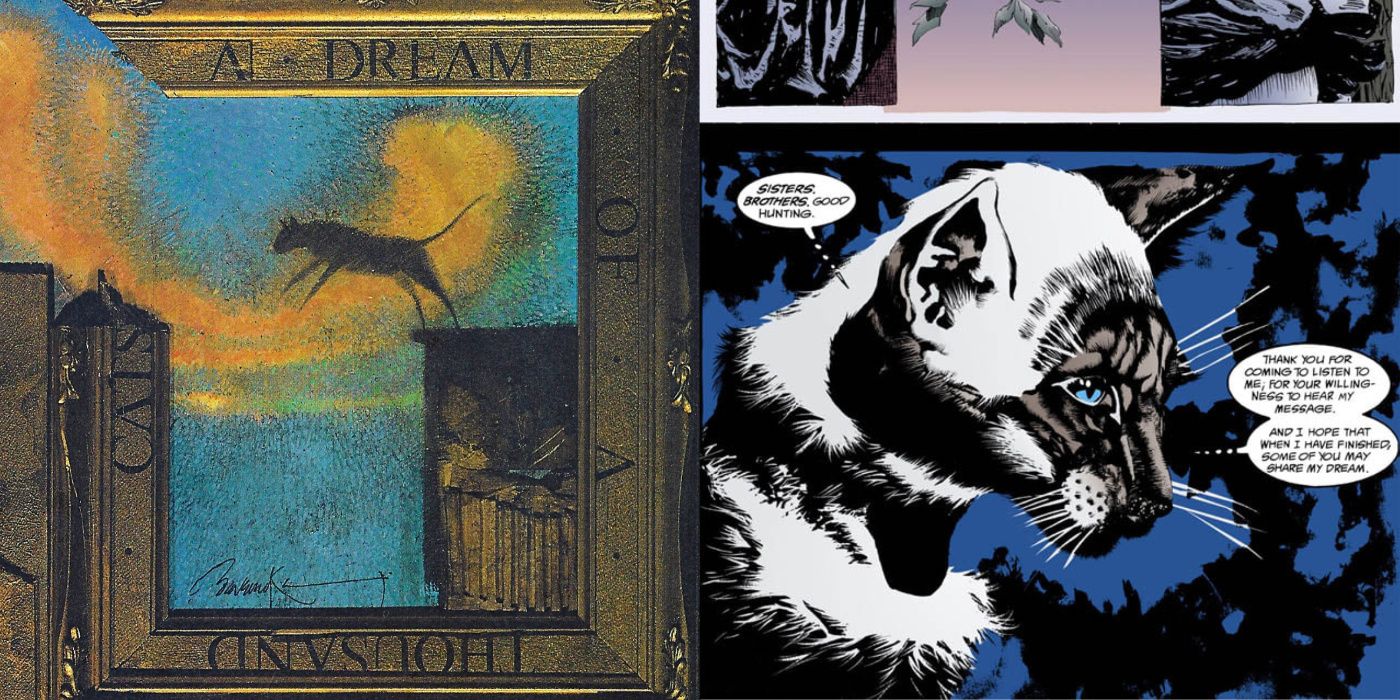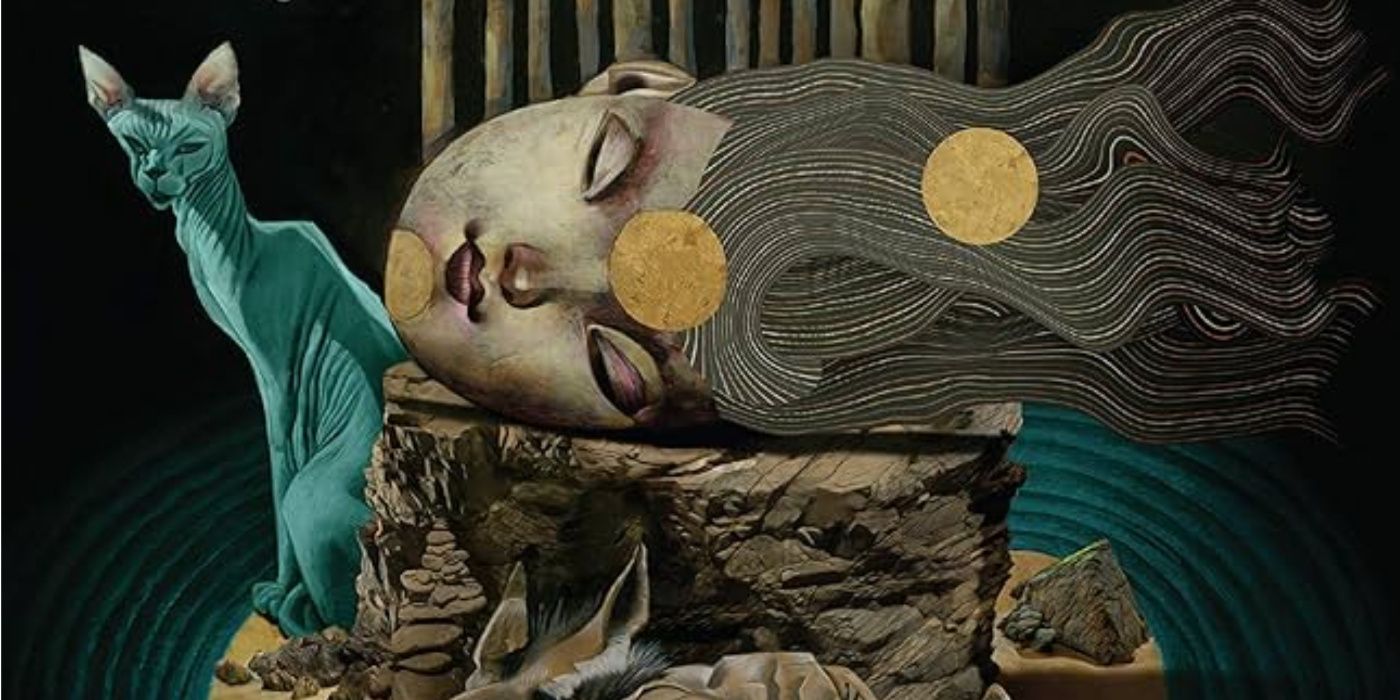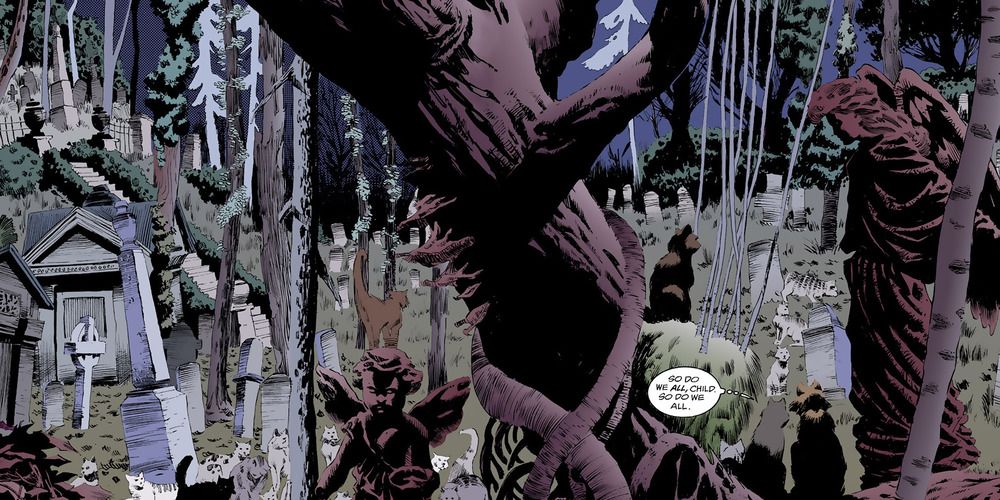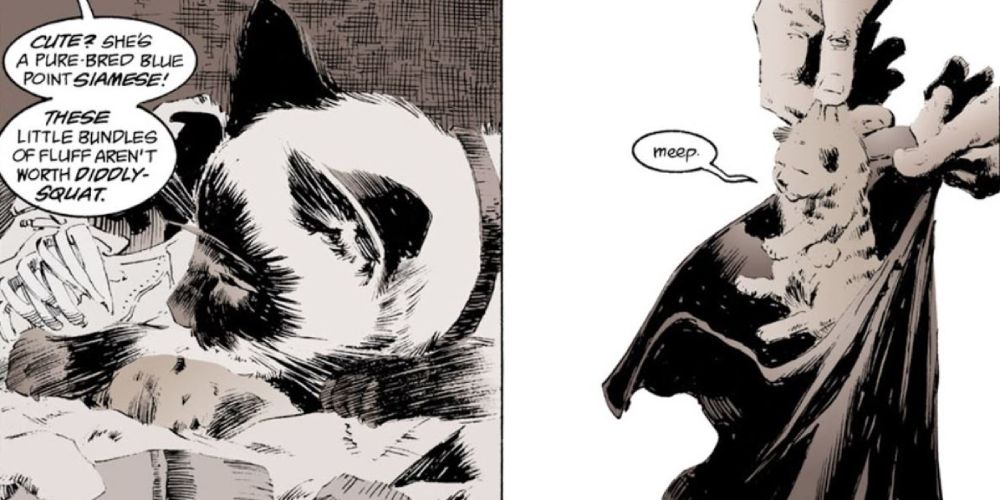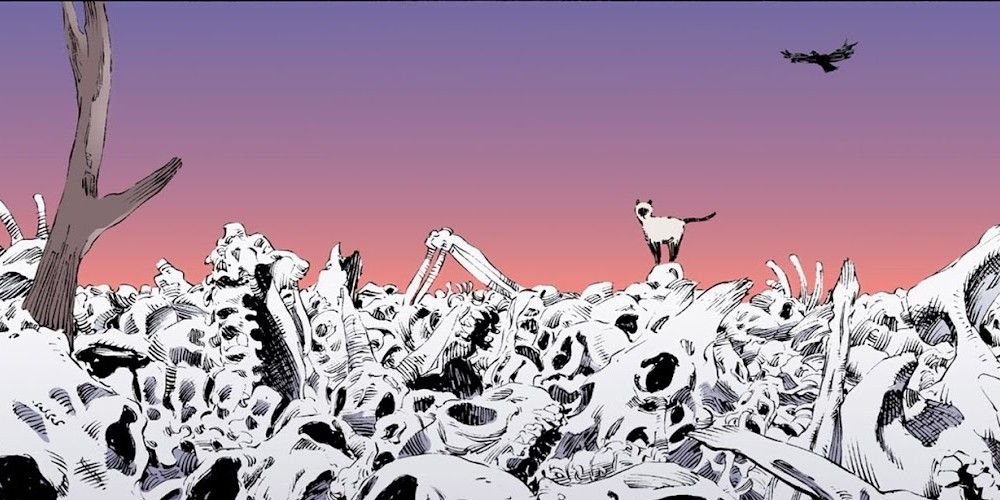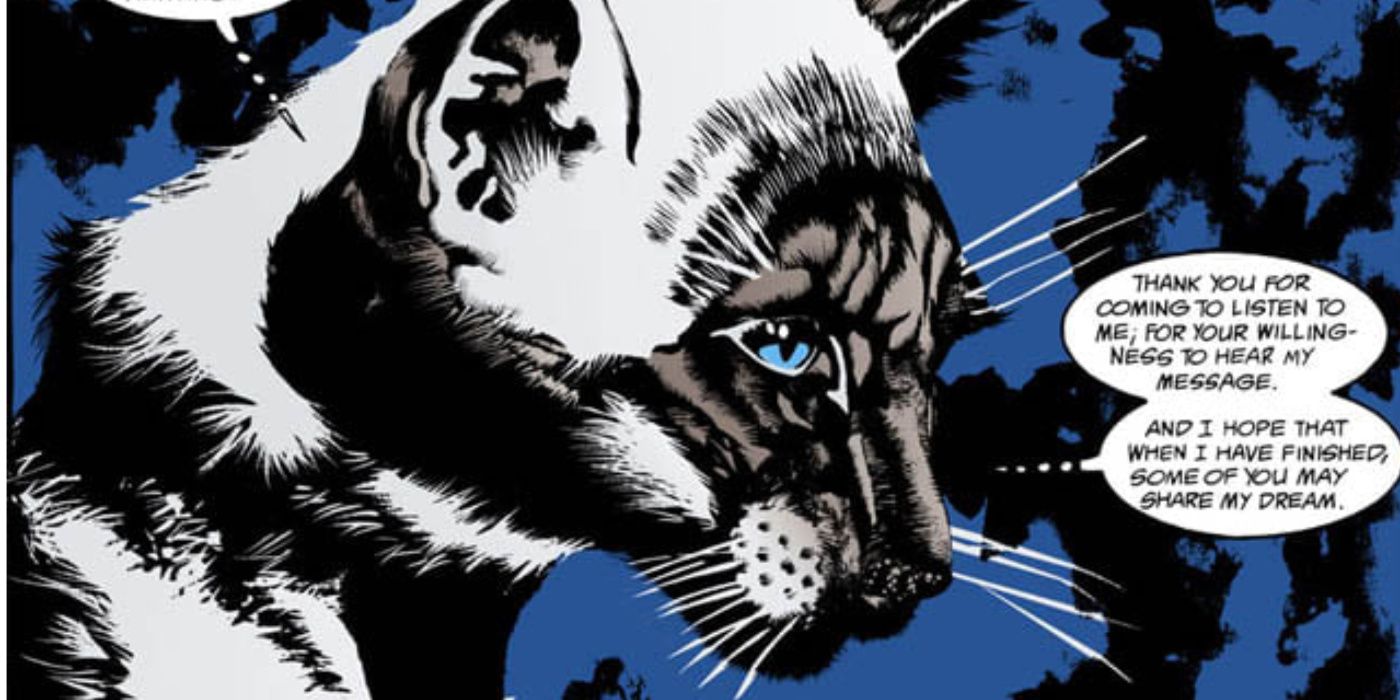This article is part of CBR's 31 Days of Halloween Event. Read the rest here!
Neil Gaiman's The Sandman masterpiece has aged incredibly well, constantly finding new fans. The main reason for this is because of how varied The Sandman is as a work. Gaiman draws from multiple places for the stories in the book, giving readers amazing tales from multiple genres. There are many people out there that forget that The Sandman was originally meant to be a horror series, but people forget that because of how Gaiman writes horror.
Several of the best horror stories in The Sandman's illustrious history came in the issues collected into the third volume of the collected editions known as Dream Country. Each of these four story has something special going on, but the one that is possibly the most unique is The Sandman #18, the story titled "A Dream of a Thousand Cats", by Gaiman, Kelley Jones, Malcolm Jones III, Robbie Busch, and Todd Klein. The story might not seem overly horrific, but a closer look at the issue reveals that it is much more unnerving than it seems.
A Walk In The Country
The Sandman walked its own path for its entire run. The book's first two story arcs had groomed readers to expect more of the same, but one thing Gaiman wanted to avoid was to jump from story to story with the fate of the Dreaming at stake. Preludes and Nocturnes and The Doll's House were both stories that ended up with a final battle of sorts. Gaiman revealed in The Sandman Companion that he wanted to avoid the book becoming like an X-Men comic, and that was the point of the four issues that make up the book's third collection, Dream Country. These four one and done stories all took readers to different places. Down the road, Gaiman will do several more batches of short stories, with the last one, World's End, playing into the overall story going no in The Sandman while still presenting brilliant short stories. Dream Country was Gaiman doing a little bit of experimenting and it definitely paid off in the long run.
The Sandman's horror comic bona fides were proven early in its run, and Dream Country's issues used the book's reputation in interesting ways. "Calliope" was about the horror of bondage and what it did to a person, "Façades" is about the horrors of becoming something other than human. "A Midsummer Night's Dream" is the story with the least horror in it, being more of a straight ahead fantasy story that played into themes that Gaiman had built up to this point. "A Dream of a Thousand Cats" goes in a different direction than the other three. The horror in the issue isn't that of a monster or a villain or anything like that. Instead, "A Dream of a Thousand Cats" focuses on the tyranny that humans put others under, a world that is fundamentally broken at a level that everyone can identify but can do nothing about it. It's about the power of dreams in a world where everything feels likes it's at its darkest.
Herding Cats
"A Dream of a Thousand Cats" is very different right off the bat because, well, it's about cats. Shocking, yes, but it's also fair to point out that no one expected the book to do this, even after reading the issue's title in solicits. There's a good chance that most people thought that was a metaphor or whatever, and then picked up an issue completely about cats and wondered how that happened. This issue might not have worked if it wasn't for the art of Kelley Jones, Malcolm Jones III, and Robbie Busch. Jones had come on the book with issue seventeen, "Calliope," and his unique style was very different from Mike Dringenberg's. Jones can find the horror in any scenes he draws, something that would become apparent later when he drew Batman, and The Sandman was a great place for him to show off what he could do.
"A Dream of a Thousand Cats" takes advantage of Jones's skills as a penciler. Jones's cats are gorgeous right from the beginning, and that's very important. Jones's style could have taken the cats in different directions, but instead he got as photorealistic as possible with them. Jones's pencils, combined with Jones III's inks and Busch's colors created cats that looked as real as possible and that really helped people connect with the issue. Those cats on the page were enough to stir the hearts of even people that aren't into cats. The realism of the cat scenes was so important because for the book's narrative hook to work, people had to feel bad for these cats. They had to be able to see each cat as its own person, to feel for their plight at the hands of humanity. The art team rendering these cats with such care isn't just because everyone likes cute cats. It's because readers needed to feel bad for these majestic hunters of the night and what humanity has done to them.
The art in "A Dream of a Thousand Cats" gets progressively better because Jones and company find a way to get the emotional character beats across with their acting for the cats. That's another very important factor in this issue. Character acting in comics is an important part of an artist's repertoire and it can be hard enough for some artists with humans; nailing it with cats is difficult for anyone. Jones is able to use all the cues that cat owners recognize in their pets - body language and the eyes - to match the feeling that Gaiman places into each scene. Jones isn't always an artist that foes for subtlety - his style is made for monster comics in a lot of ways - but "A Dream of a Thousand Cats" shows just how well his style can work on a subject that is supremely hard to render.
The art team does an amazing job of capturing the animals, of rendering their emotions, and of creating a dreamscape that makes sense for a cat. The Cat of Dreams is another triumph. Morpheus is known for his various names and identities, and the Cat of Dreams perfectly captures who he is as a character. The Cat of Dreams looks like a piece of the night decided to become a cat, looking upon the world with fiery red eyes. There's a wildness to the Cat of Dreams that the art captures that isn't often there when Morpheus is in human form. Dreams are wild things and the Cat of Dreams reminds readers of that. He's alternately majestic and wild, as if he could bite the hand that he's caressing, the perfect representation of dreams. The art of "A Dream of a Thousand Cats" is gorgeous, plain and simple, and the art team works together to create an experience that readers will remember for the rest of their lives.
Dream The World
"A Dream of a Thousand Cats" is a unique experience because of the way the story is told. It's one of those stories that no one ever expected and even all these years later it stands out. A story about cats, told from the perspective of cats, is usually the stuff of children's books. This is fitting in someways, as "A Dream of a Thousand Cats" is basically a bedtime story. Readers follow a kitten as it learns the truth about the world from an elder cat who used to believe the lie that the humans loved her until they killed her children because the kittens weren't perfect. It's an extremely subtle indictment of the relationship between humans and their pets, that ownership of another sentient being that makes having a pet so creepy.
"A Dream of a Thousand Cats" keeps surprising readers with every panel. What makes it stand apart is how it plays on the heartstrings. The story of the Siamese is one of tragedy; she finds a tom, has a night of passion, and dreams of what her babies will be like. She experiences true love for the first time in her life - and she knows it - and then the humans take it from her. Her life is broken by casual cruelty and she goes on a desperate quest for answers. Gaiman is able to make each moment inflame the passions of the readers. The readers understand her and what she wants out of the world, and they understand just what she lost. Her hatred of humans burns brightly for everyone that reads the story.
Emotion is the key to this story and it's where the horror comes from. Imagine being a thing that thought it was free and then learning that its entire life is subjugation. The Siamese loses everything when her kittens are taken from her. Her world no longer makes sense and Gaiman is able to sell to that the readers. However, the best trick is yet to come. When the Siamese learns the truth about the world from the Cat of Dream, readers are treated to a feeling of exultation, of a world that finally makes sense. Morpheus is the father of myths in The Sandman, and the one that is spun for the Siamese has the all hallmarks of a great myth. The reader is swept along with her, into a world of cat lords and ladies, one where the humans are little more than pets. It doesn't matter that the world of cats is just as bad as that of humans; what matters is that the monsters are getting their just deserves.
"A Dream of a Thousand Cats" is about how dreams mold the universe. It's a story about being kept in cages and given the illusion of freedom. It's about breaking through that and convincing the other prisoners that they are in cages too. "A Dream of a Thousand Cats" is about the importance of rebellion and of breaking the yoke that other put on us. It's a dark story, there's no doubt about that, but it's also one of hope. "A Dream of a Thousand Cats" teaches the reader to keep fighting, to keep dreaming, no matter how hard it seems.
One Cat At A Time
The Sandman is often philosophical, something that shines through in "A Dream of a Thousand Cats." It's a story that has no business working as well as it does, and that's the best part of it. Gaiman, Jones, Jones III, Busch, and Klein show readers a world that we walk through every day, but a different view of it. The story is a metaphor for oppression and rebellion. Its shows the casual barbarism inflicted upon the weak by the strong and how sometimes, dreams are the only way to fight such a thing.
It doesn't matter that the dream is possibly false, that there might have never been a world of cat lords and ladies. All that matters is that dream gives hope, it gives succor to those in pain. "A Dream of a Thousand Cats" is a fanciful Sandman tale about the power of dreams and what they can help people achieve. It's also an example of phenomenal art. Jones, Jones III, and Busch work together to create the visuals that make this issue truly soar. Comics are a visual medium, after all, and this issue takes advantage of that beautifully. Gaiman's story is great, but it never would have worked nearly as well without the art team, who would go on to do brilliant work in Seasons of Mist. "A Dream of a Thousand Cats" is a feast for the sentence, making readers into a cat lord or lady, running through the primordial world, playing the game of cat and human.

